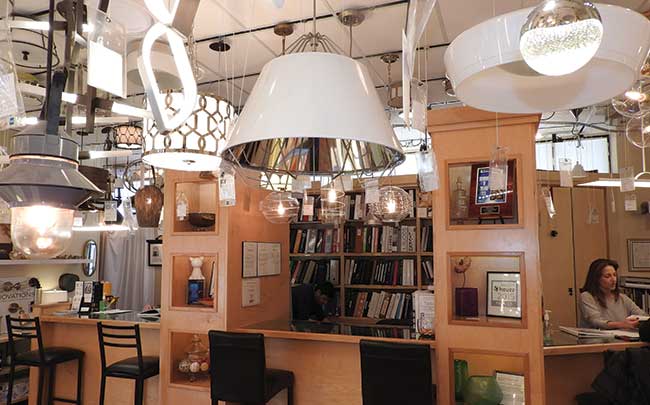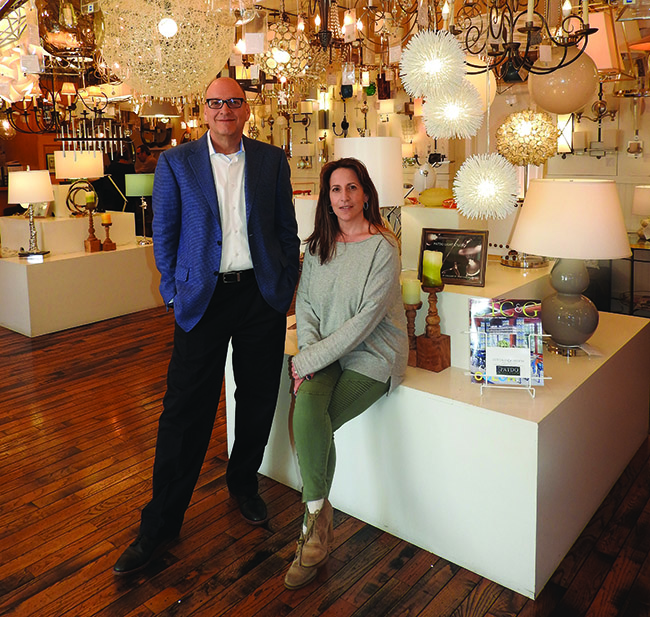Measuring less than 2,000 square feet, Patdo Light Studio is “more than [customers] will ever need” to find just the right lighting for their project.
Overhearing Mari-Lou Nania consult with a couple about lighting selection at Patdo Light Studio is probably not that different from a session with a therapist. Not only is her voice soothing as she offers expert suggestions, but all of her non-verbal communication makes it abundantly clear that she is genuinely and unequivocally interested in helping them. After the time they spend together, these clients will come away with the comfort that someone has understood their wants and needs and has given them her undivided attention.

Providing great customer service is a key attribute in the hotel industry, which was Mari-Lou Nania’s chosen career path after college — but that’s not where she first learned this skill. She grew up in Westchester, New York helping her parents Bob and Mariann Durso in their electrical supply business. Over the summers, Nania helped out by doing office work and naturally would observe her mom and dad guiding customers on their lighting choices.
The Dursos’ professional advice engendered trust and loyalty among the area’s commercial and residential construction community and, as a result, their business was able to withstand the arrival of neighboring home centers in the 1980s and ’90s. Even so, Bob Durso took time to closely examine the competition.
“My father saw that Home Depot was selling [the same parts] for less than he could buy it for,” Nania explains. To prevent any erosion of his business, Bob Durso decided to develop a lighting showroom that could offer decorative products that the home centers did not. Since Mariann had a good eye for fine design, the couple focused on high-end Italian lighting from manufacturers such as Leucos, Artermide, and Flos, among others. Mariann handled the purchasing and day-to-day operations for the lighting showroom portion of the business while Bob maintained the commercial side of it, working on sizable jobs such as providing street lights for the Hutchinson River Parkway – one of New York City’s main arteries – among many other large projects in the Manhattan area.

As the lighting showroom business blossomed, there was a need to hire additional lighting designers. Through their good relationship with the Flos sales representative, the Dursos were introduced to award-winning lighting designer Gary Novasel, who came on board. Eventually Patdo Light Studio (the name is an amalgam of Patricia, their youngest daughter, plus the family name) has grown to include 14 lighting designers on staff, six of whom specialize in commercial projects.
When the Dursos decided to retire, they asked Mari-Lou – the only child among their four daughters to have spent any time working in the showroom – if she could take over. At the time, Nania was enjoying success in the hospitality industry. Knowing how much the business meant to her parents but a bit reluctant to abandon her own career, she agreed to their request on one condition: they must let her run the operation autonomously. Mari-Lou shadowed her mom for a period of time, learning the ropes – including a trip to the lighting fair Euroluce in Milan, where Mariann introduced her daughter to the factories she worked with – until both felt she was ready. “My mom said, ‘The student has surpassed the teacher,’” she remarks.
Nania was fortunate in that her parents made sure the business was financially secure and healthy before handing over the reins. “They didn’t want me to be saddled with debt,” she comments. Since the transition, Nania handles the showroom division as Showroom Principal, while Novasel took on the duties of Design Principal. “We asked the employees if they wanted to stay on, and all of them did,” she states, adding, “Some have been with us since the beginning, going back 18 or 20 years.”
Most of the employees aren’t seasoned lighting professionals when they are hired at Patdo. Instead they hone their lighting skills at the same time that they’re learning the company’s culture. “We want everyone to feel like this is their own little business,” Nania explains. That practice is just one reason why the business has such loyalty among its employees and customers.
The Difference
The goal at Patdo is “to make sure the client has an amazing experience,” Nania comments. For starters, every phone call or email gets returned in a timely manner. “Even if you don’t have any more information since the last time you spoke to the client, you still call and let him/her know that,” Novasel says. “Nothing makes me angrier [as a customer] than when I don’t hear anything. That makes me feel like I’m not important.”
Other showrooms, home centers, and even Internet pricing are no threat, according to Nania and Novasel. “Nobody does what we do [in customer service],” she comments. “We make sure that even the customer who comes in for a single pendant is getting the proper lighting for their home.”
All too often at other showrooms or a home center, a customer who walks in requesting a pendant light will probably go to the pendant section, choose a color/style from off the shelf based on what’s hanging up, and purchase it. In other instances, customers who say they want to buy a pendant might be guided by a store employee who helps them select the color/style they want, but never asks why they want a pendant.
At Patdo, a conversation that might start with, “I’m looking for a pendant” would evolve into a discussion that considers the ceiling height and the overall architecture or décor style of the room. As a result of such careful analysis, very often the clients end up deciding on something completely different than what they thought they needed when they walked in. Or, if the consensus is that a pendant would be perfect, the customer feels confident in his/her choice because it was assessed by a lighting professional.
Internet shopping isn’t perceived as a threat by Nania and Novasel because of lighting’s complexity. “To do lighting right, you need to see the output and do a comparison of [one bulb’s characteristics versus another] to see which one you like better. You can’t do that on a computer screen,” Novasel comments.
In-Depth Analysis
Inside Patdo’s light lab – where its track, recessed, and control products are displayed – there is a landscape painting chosen specifically because it beautifully demonstrates how “warm” light changes the painting’s colors versus “cool.” To see these changes in person has a huge impact on clients.
The light lab is also where the staff conducts their own evaluation of products. “We check the compatibility of every lamp to the dimmers and then each with the transformers,” Novasel remarks, adding, “There’s less of an issue now [with dimmer/transformer compatibility] than there has been in the past.”
By doing their own assessment of the bulbs, dimmers, and transformers they carry, Patdo employees can better find a lighting solution tailored to the customers’ needs — especially when it comes to LEDs. “We are very cautious when it comes to spec’ing LED,” Nania states. “For example, manufacturers often don’t list the delivered lumens on their packaging, only what the lumens are for that chip.” This is an example of just one of the small details that is routinely overlooked when a customer shops online for LED.
“When the choices were between incandescent, halogen, and fluorescent, everyone knew what each one looked like,” Novasel remarks. “LED is so complicated. We want customers to see if they like 2700K or 3000K. I think LED technology has made it easier for us [to sell lighting].”
Size Isn’t Everything
There is the occasional consumer who comes into the showroom, turns around within the 1,600-sq.-ft. or so space and sniffs, “Is this all you have?” Nania, Novasel, and their staff are quick to point out that what makes their store different is that it is a curated selection of the best of what’s out there. “I tell them it’s more than you ever need because you get us,” Nania says. “Sure we can show you something that is hanging on display, but we want to find something unique for you.”
Having an edited selection of premium products with experts’ guidance on each – plus an immense amount of manufacturer catalogs on-hand – is also a helpful way to keep the customer from feeling overwhelmed by the magnitude of choices.
Despite the small footprint of the store, Patdo does a staggering amount of business. “We don’t advertise. [Big] commercial work, boutique stores, and restaurants find us,” Nania states. “Very often customers are referred to us by electricians and architects who have worked with us in the past.” Indeed the full-time staff of 14 designers are at maximum capacity with projects.
Due to the showroom’s modest size, products change regularly. “We refreshen often so we’re not selling yesterday’s news,” Novasel states. The display products that are taken down are donated to Habitat for Humanity’s Re-Store shop. ‘”We donated $30,000 worth of lighting last year,” Nania adds. The display windows also frequently change, but always have a theme as well as new products. On social media, Patdo often encourages its fans to “come see our new windows.” For residents and businesses in the New York City metro area, traveling to Patdo to see the latest has become part of their routine.





